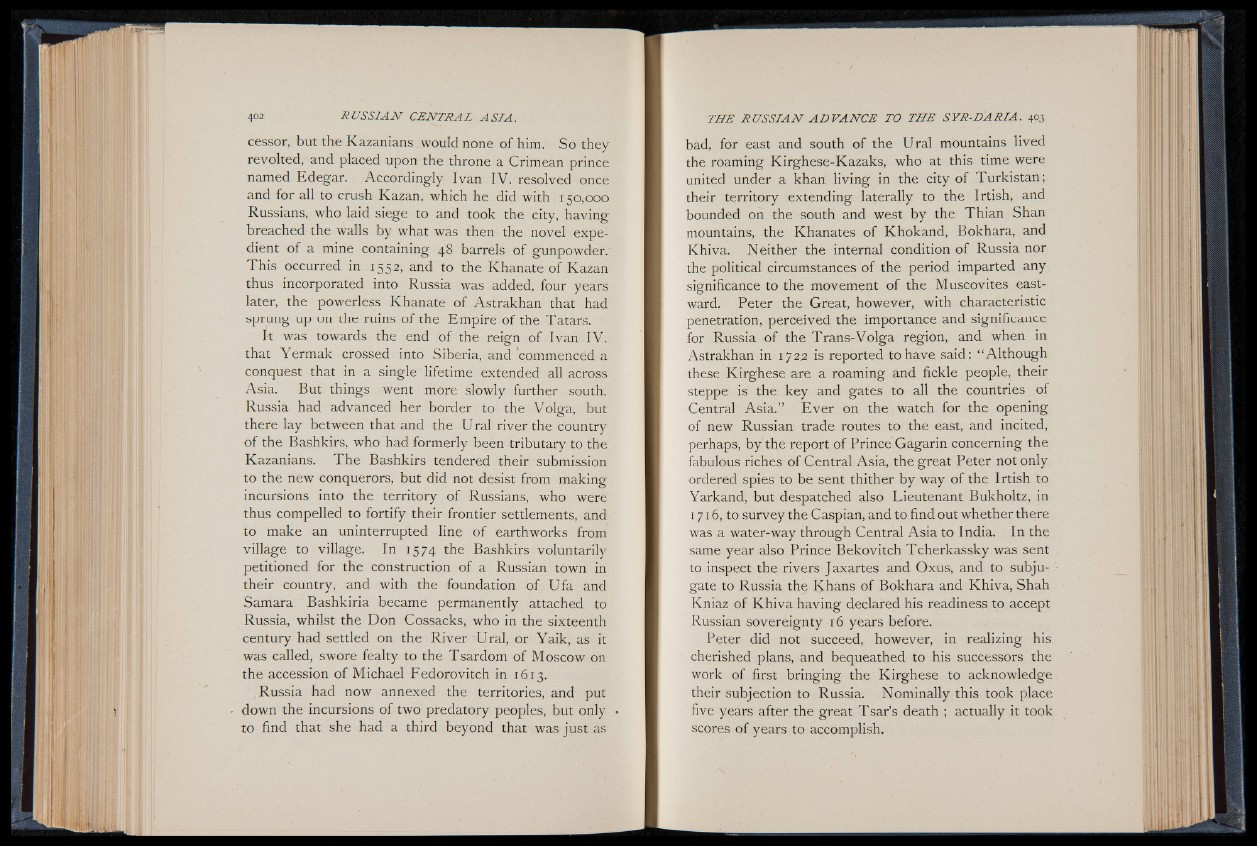
cessor, but the Kazanians ^would none of him. So they
revolted, and placed upon the throne a Crimean prince
named Edegar. Accordingly Ivan IV. resolved once
and for all to crush Kazan, which he did with 150,000
Russians, who laid siege to and took the city, having
breached the walls by what was then the novel expedient
of a mine containing 48 barrels of gunpowder.
This occurred in 1552, and to the Khanate of Kazan
thus incorporated into Russia was added, four years
later, the powerless Khanate of Astrakhan that had
sprung up on the ruins of the Empire of the Tatars.
It was towards the end of the reign of Ivan IV.
that Yermak crossed into Siberia, and commenced a
conquest that in a single lifetime extended all across
Asia. But things went more slowly further south.
Russia had advanced her border to the Volga, but
there lay between that and the Ural river the country
of the Bashkirs, who had formerly been tributary to the
Kazanians. The Bashkirs tendered their submission
to the new conquerors, but did not desist from making
incursions into the territory of Russians, who were
thus compelled to fortify their frontier settlements, and
to make an uninterrupted line of earthworks from
village to village. In 1574 the Bashkirs voluntarily
petitioned for the construction of a Russian town in
their country, and with the foundation of Ufa and
Samara Bashkiria became permanently attached to
Russia, whilst the Don Cossacks, who in the sixteenth
century had settled on the River Ural, or Yaik, as it
was called, swore fealty to the Tsardom of Moscow on
the accession of Michael Fedorovitch in 1613.
Russia had now annexed the territories, and put
down the incursions of two predatory peoples, but only
to find that she had a third beyond that was just as
bad, for east and south of the Ural mountains lived
the roaming Kirghese-Kazaks, who at this time were
united under a khan living in the city of Turkistan;
their territory extending laterally to the Irtish, and
bounded on the south and west by the Thian Shan
mountains, the Khanates o f Khokand, Bokhara, and
Khiva. Neither the internal condition of Russia nor
the political circumstances of the period imparted any
significance to the movement of the Muscovites eastward.
Peter the Great, however, with characteristic
penetration, perceived the importance and significance
for Russia of the Trans-Volga region, and when in
Astrakhan in 172,2 is reported to have said: “ Although
these Kirghese are a roaming and fickle people, their
steppe is the key and gates to all the countries of
Central Asia.” Ever on the watch for the opening
of new Russian trade routes to the east, and incited,
perhaps, by the report of Prince Gagarin concerning the
fabulous riches of Central Asia, the great Peter not only
ordered spies to be sent thither by way of the Irtish to
Yarkand, but despatched also Lieutenant Bukholtz, in
1716, to survey the Caspian, and to find out whether there
was a water-way through Central Asia to India. In the
same year also Prince Bekovitch Tcherkassky was sent
to inspect the rivers Jaxartes and Oxus, and to subjugate
to Russia the Khans of Bokhara and Khiva, Shah
Kniaz of Khiva having declared his readiness to accept
Russian sovereignty 16 years before.
Peter did not succeed, however, in realizing his
cherished plans, and bequeathed to his successors the
work of first bringing the Kirghese to acknowledge
their subjection to Russia. Nominally this took place
five years after the great Tsar’s death ; actually it took
scores of years to accomplish.